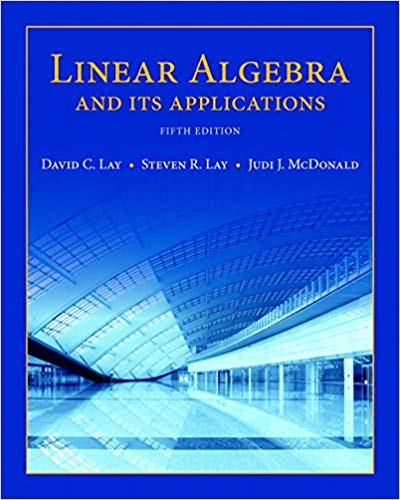
Linear Algebra and Its Applications, 5th Edition
Authors: David C. Lay, Steven R. Lay, Judi J. McDonald
ISBN-13: 978-0321982384
We have solutions for your book!
See our solution for Question 23E from Chapter 1.3 from Lay's Linear Algebra and Its Applications, 5th Edition.
Problem 23E
Chapter:
Problem:
In Exercises 23 and 24, mark each statement True or False. Justify each answer...
Step-by-Step Solution
Step 1
We are given with some statements, we have to state whether the statements are True of False and also justify for the sane.
Step 2: Statement (a)
The Statement:
Another notation for the vector $\left[ {\begin{array}{*{20}{c}}{ - 4}\\3\end{array}} \right]$ is $\left[ {\begin{array}{*{20}{c}}{ - 4}&3\end{array}} \right]$.
The Statement is True, as a vector can be written as both column form or row form.
Step 3: Statement (b)
The Statement:
The points in the plane corresponding to [-2, 5] and [-5, 2] lie on a line through the origin
The line which passes through origin and the point [-2,5] are set of points that span $V$. Now if the point [-5,2] has to lie on the same line, it should lie in the span of $V$. In other words it should be a scaler multiple of the vector [-2,5].$$\begin{array}{l}c\left[ {\begin{array}{*{20}{c}}{ - 2}\\5\end{array}} \right] = \left[ {\begin{array}{*{20}{c}}{ - 5}\\2\end{array}} \right]\\\\ - 2c = - 5 \Rightarrow c = \dfrac{5}{2}\\5c = 2 \Rightarrow c = \dfrac{2}{5}\end{array}$$As we get different values of the scaler.
The Statement is FALSE.
Step 4: Statement (c)
The Statement:
An example of a linear combination of vectors $v_1$ and $v_2$ is the vector $\dfrac{1}{2}{v_1}$
The linear combination of two vectors $v_1$ and $v_2$ is given by:\[{c_1}{v_1} + {c_2}{v_2}\]Now if we choose \[\begin{array}{l}{c_1} = \dfrac{1}{2}\,\,\\{c_2} = 0\end{array}\]The Linear combination becomes:\[\begin{array}{l}{c_1}{v_1} + {c_2}{v_2} = \dfrac{1}{2}{v_1} + 0{v_2}\\{c_1}{v_1} + {c_2}{v_2} = \dfrac{1}{2}{v_1}\end{array}\]Therefore the Statement is TRUE
Step 5: Statement (d)
The Statement:
The solution of the linear system whose augmented matrix is $\left[ {\begin{array}{*{20}{c}}{{{\bf{a}}_{\bf{1}}}}&{{{\bf{a}}_{\bf{2}}}}&{{{\bf{a}}_{\bf{3}}}}&{{{\bf{b}}}}\end{array}} \right]$ is the same as the solution set of the equation ${x_1}{{\bf{a}}_{\bf{1}}} + {x_2}{{\bf{a}}_{\bf{2}}} + {x_3}{{\bf{a}}_{\bf{3}}} = {\bf{b}}$
BY the definition of Augmented matrix, the vector $b$ can be generated by the vectors ${{\bf{a}}_{\bf{1}}},\,\,{{\bf{a}}_{\bf{2}}},\,\,{{\bf{a}}_{\bf{3}}}$. Hence writing the vector $b$ as a linear combination, we have:\[\left[ {\begin{array}{*{20}{c}}{{{\bf{a}}_{\bf{1}}}}&{{{\bf{a}}_{\bf{2}}}}&{{{\bf{a}}_{\bf{3}}}}&{{{\bf{a}}_{\bf{4}}}}\end{array}} \right] \Leftrightarrow {x_1}{{\bf{a}}_{\bf{1}}} + {x_2}{{\bf{a}}_{\bf{2}}} + .{x_3}{{\bf{a}}_3} = {\bf{b}}\]Therefore the Statement is TRUE
Step 6: Statement (e)
The Statement:
The set span {u,v} is always visualized as a plane through the origin
In case, vector $v$ is a scalar multiple of $u$, then\[{\rm{span}}\left\{ {{\bf{u,v}}} \right\} = span\left\{ {\bf{u}} \right\}\]So the ${\rm{span}}\left\{ {{\bf{u,v}}} \right\} = span\left\{ {\bf{u}} \right\}$ is not always visualized as a plane, it can also be a line. Therefore the Statement is FALSe
ANSWERS
\[\begin{array}{l}\left( a \right):\,{\rm{TRUE}}\\\left( b \right):\,{\rm{FALSE}}\\\left( c \right):\,{\rm{TRUE}}\\\left( d \right):\,{\rm{TRUE}}\\\left( e \right):\,{\rm{FALSE}}\end{array}\]
We are given with some statements, we have to state whether the statements are True of False and also justify for the sane.
Step 2: Statement (a)
The Statement:
Another notation for the vector $\left[ {\begin{array}{*{20}{c}}{ - 4}\\3\end{array}} \right]$ is $\left[ {\begin{array}{*{20}{c}}{ - 4}&3\end{array}} \right]$.
The Statement is True, as a vector can be written as both column form or row form.
Step 3: Statement (b)
The Statement:
The points in the plane corresponding to [-2, 5] and [-5, 2] lie on a line through the origin
The line which passes through origin and the point [-2,5] are set of points that span $V$. Now if the point [-5,2] has to lie on the same line, it should lie in the span of $V$. In other words it should be a scaler multiple of the vector [-2,5].$$\begin{array}{l}c\left[ {\begin{array}{*{20}{c}}{ - 2}\\5\end{array}} \right] = \left[ {\begin{array}{*{20}{c}}{ - 5}\\2\end{array}} \right]\\\\ - 2c = - 5 \Rightarrow c = \dfrac{5}{2}\\5c = 2 \Rightarrow c = \dfrac{2}{5}\end{array}$$As we get different values of the scaler.
The Statement is FALSE.
Step 4: Statement (c)
The Statement:
An example of a linear combination of vectors $v_1$ and $v_2$ is the vector $\dfrac{1}{2}{v_1}$
The linear combination of two vectors $v_1$ and $v_2$ is given by:\[{c_1}{v_1} + {c_2}{v_2}\]Now if we choose \[\begin{array}{l}{c_1} = \dfrac{1}{2}\,\,\\{c_2} = 0\end{array}\]The Linear combination becomes:\[\begin{array}{l}{c_1}{v_1} + {c_2}{v_2} = \dfrac{1}{2}{v_1} + 0{v_2}\\{c_1}{v_1} + {c_2}{v_2} = \dfrac{1}{2}{v_1}\end{array}\]Therefore the Statement is TRUE
Step 5: Statement (d)
The Statement:
The solution of the linear system whose augmented matrix is $\left[ {\begin{array}{*{20}{c}}{{{\bf{a}}_{\bf{1}}}}&{{{\bf{a}}_{\bf{2}}}}&{{{\bf{a}}_{\bf{3}}}}&{{{\bf{b}}}}\end{array}} \right]$ is the same as the solution set of the equation ${x_1}{{\bf{a}}_{\bf{1}}} + {x_2}{{\bf{a}}_{\bf{2}}} + {x_3}{{\bf{a}}_{\bf{3}}} = {\bf{b}}$
BY the definition of Augmented matrix, the vector $b$ can be generated by the vectors ${{\bf{a}}_{\bf{1}}},\,\,{{\bf{a}}_{\bf{2}}},\,\,{{\bf{a}}_{\bf{3}}}$. Hence writing the vector $b$ as a linear combination, we have:\[\left[ {\begin{array}{*{20}{c}}{{{\bf{a}}_{\bf{1}}}}&{{{\bf{a}}_{\bf{2}}}}&{{{\bf{a}}_{\bf{3}}}}&{{{\bf{a}}_{\bf{4}}}}\end{array}} \right] \Leftrightarrow {x_1}{{\bf{a}}_{\bf{1}}} + {x_2}{{\bf{a}}_{\bf{2}}} + .{x_3}{{\bf{a}}_3} = {\bf{b}}\]Therefore the Statement is TRUE
Step 6: Statement (e)
The Statement:
The set span {u,v} is always visualized as a plane through the origin
In case, vector $v$ is a scalar multiple of $u$, then\[{\rm{span}}\left\{ {{\bf{u,v}}} \right\} = span\left\{ {\bf{u}} \right\}\]So the ${\rm{span}}\left\{ {{\bf{u,v}}} \right\} = span\left\{ {\bf{u}} \right\}$ is not always visualized as a plane, it can also be a line. Therefore the Statement is FALSe
ANSWERS
\[\begin{array}{l}\left( a \right):\,{\rm{TRUE}}\\\left( b \right):\,{\rm{FALSE}}\\\left( c \right):\,{\rm{TRUE}}\\\left( d \right):\,{\rm{TRUE}}\\\left( e \right):\,{\rm{FALSE}}\end{array}\]